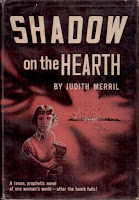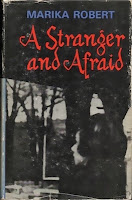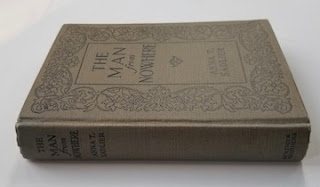For this Easter Sunday, 'In Memoriam—H.W.L., A Noble Teacher' by Agnes Maule Machar, "first of Dominion poetesses." It is a celebration of a holy day, a celebration of faith, and a memorial to a beloved teacher. The version below is taken from Lays of the 'True North' and Other Canadian Poems (Toronto: Copp, Clark, 1899), in which the poet provides a note identifying "H.W.L." as "Hannah W. Lyman, first Principal of Vassar College, New York State, and previously an esteemed teacher in Montreal, Canada."
I admit to having being confused when I first came upon this poem; it was my understanding that Agnes Maule Machar's father, Presbyterian clergyman John Machar, had been solely responsible for her education. Further investigation revealed that daughter Agnes had spent one – and only one – year at Ipswich Seminary, a Montreal boarding school run by Miss Lyman.
Though a Montrealer – born, bred, and educated – it wasn't until recently that I'd so much as heard the name Hannah W. Lyman. Henry James Morgan's wonderful two-volume Types of Canadian Women and of Women Who Are or Have Been Connected with Canada (Toronto: William Briggs, 1903) – source of the images used in this post – speaks to her importance and influence on the city:
Miss Hannah Willard Lyman, a successful and inspiring teacher of youth, was born at Old Northampton, Mass., in 1816, and died at Poughkeepsie, N.Y., where she was vice- principal of Vassar College, February 21st, 1871. She commenced to teach at Gotham Academy, Maine, and she subsequently taught in Mrs. Gray's Seminary for Young Ladies at Petersburg, Virginia. For the next twenty-two years she conducted a seminary for young ladies, in Montreal, which took the lead of all similar institutions in the Canadas. Her natural gifts, amounting almost to a genius for her profession, were enriched by an education of no ordinary range. She was a sister of Rev. Henry Lyman, a missionary, who was murdered by the natives in Sumatra in 1832, and whose life she has written {New York: 1857); also of the late Lieut.-Colonel Theodore Lyman, and the late Colonel S.J. Lyman, of Montreal. The Rev. Dr. Campbell, in his "History of the St. Gabriel Street Church, Montreal," says that "the name of Miss Lyman is yet as ointment poured forth in many hearts and homes, not only in Montreal, but all through Canada, for the blessed influences which she exerted as an instructor of young ladies." A memorial of her is preserved in McGill University by the "Hannah Willard Lyman Fund," raised by subscriptions from her former pupils, and invested as a permanent endowment to furnish annually a scholarship or prizes in a college for women affiliated to the university, or in classes for the higher education of women. Her remains were brought to Montreal and laid in Mount Royal Cemetery.Sadly, it seems the memorial preserved in McGill University is no more.
A remarkable woman. Would that I could've visited her gravesite this Easter, but in this time of crisis it's closed for all but essential services.
IN MEMORIAM
H. W. L., A NOBLE TEACHER
'Tis once again the Eastertide,
So bright, so full of summer calm;
So fair the quiet waters glide,
The air so full of fragrant balm,
That earth and sky and crystal tide
Seem chanting sweet an Easter psalm;
So, to her risen Saviour-King,
Methinks—a ransomed earth might sing.
How brightly in the sacred chain
Of thoughts that with the season blend,
Thy well-known image shines again
In memory's light, beloved friend!
Though now we seek thy smile in vain,
Our converse hath not here its end;
So linked art thou with this blest day
Thou scarcely seemest passed away!
Thine Easter song shall sweetly flow,
Unmingled now with loss or pain,
And we in shadow here below
Can almost hear the joyous strain;
For 'Worthy is the Lamb,' we know,
Is evermore the glad refrain;
How, in the sunshine of His grace,
Must thou rejoice to see His face!
We still must keep the feast below,
Partake the sacramental wine;
Thou needest no memorials now
In presence of the Living Vine.
Yet, though our tears will have their flow
We would not at thy gain repine;
For our communion still shall be
With thee—through Christ in Him with Thee!
We know not what new realms of thought
Have opened to thine eager gaze;
We know not how thy soul is taught
The knowledge of God's hidden ways;
How problems once with mystery fraught
Now fill thy heart with grateful praise,
While we must wander still and wait
In the dim light without the gate!
But well we know thy longing heart
Hath seen fulfilled its sweetest dreams;
Hath found its ever-blessed part
In that deep love whose gladsome beams
It sought afar—as seeks the hart,
Athirst, the crystal-flowing streams,
Now, bathing in that glorious tide,
At last, at last is—satisfied!
Well—though we cannot grasp the bliss
That fills thy cup of gladness there,
Nor know what we shall gain or miss
In life that tends—we know not where,
We may go forward, knowing this—
Who cared for thee for us will care—
And, in the 'many mansions,' we
At last shall share thy rest with thee.
But while on earth shall lie our lot,
We cherish still the thought of thee;
The living lesson thou hast taught
Of faith and hope and charity.
The life with patient labour fraught,
From self and selfish aims set free;
A power our slower hearts to move,
To follow in thy path of love!
We thank God for thy life below,Wishing all a Happy Easter.
We thank Him for the quiet rest
Of which such toilers only know
The sweetness, when at length possessed.
The words that here thou lovedst so,
In whose fulfilment thou art blest,
Those words of comfort, still and deep,
We softly murmur while we weep:
'He giveth His beloved sleep!'
Stay healthy.
Stay safe.
Related posts:





































